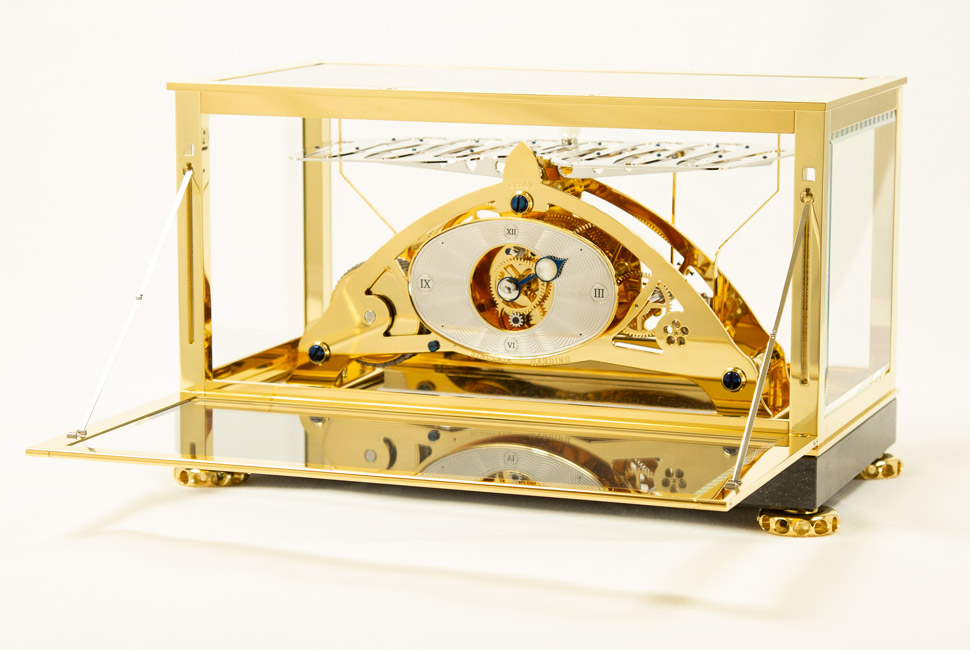Time looked likely to have passed clocks by almost entirely. What were Clock & Watch departments at the auction houses, dropped the clock from the title years ago as antiquarian interest in the likes of Frodsham or Dent gave way to super-heated frenzies over the latest rare Daytona to be winkled out by the likes of Aurel Bacs at Phillips and Sam Hines at Sothebys.
Long-case grandfather clocks are rarely more than title props on the Antiques Roadshow and travel alarms went the way of the jet-set aeons ago. Exceptionally, historically important clocks such as the 1693 Tompion make serious money (just short of £2million last year at Bonhams) but otherwise, clocks have been the poor relations for years. However, that looks like changing. We’re not about to all go out and buy grandfather clocks again, but there’s growing interest in contemporary clocks from a surprisingly wide range of manufacturers and designers. Some are established makers that have simply found a new mojo, some are new entrants and others have just shifted their attention to a market that’s warming up nicely – you can easily imagine that the advent of Zoom-working will add an extra fillip to sales.
There is a growing interest in contemporary clocks…

Best-known in the never-quite-went-away category are Jaeger-LeCoultre and the Atmos. The Atmos is something of a curiosity, working as it does through tiny variations in temperature expanding and contracting a bellows-like capsule attached to the mainspring, the energy produced is tiny but as it only “ticks” at a leisurely twice per minute, that’s not a problem and it means that the clock can run for years. Made in small numbers ever since the 1930s, it’s been in the catalogue ever since. What’s made its popularity tick up steadily is that the simplicity of the movement makes it the perfect canvas for contemporary designers to work on – the leisurely rotation of the balance weight has been the animating force behind designs from Hermès and Marc Newson as well as the maison’s in-house teams.
Patek Philippe never stopped making clocks either, though in its case, the clocks work as vehicles to show off what it calls “rare handcrafts”, a catch-all that includes various forms of enamelling, marquetry and other techniques. It’s a combination of smart
design and the kinetic element that gives contemporary clockmaking (there’s a phrase you don’t hear so often) a bright future. MB&F have been at the forefront of creative watchmaking for over a decade and for them, the transition to making clocks was both natural and somewhat tangential.

Four years after launching their first watch, MB&F opened the M.A.D. Gallery in Geneva’s Old Town as a showcase for the watches and what they called “mechanical art devices”. This included anything from mechanical desk toys to outlandishly customised motorbikes and it wasn’t long before M.A.D. started collaborating with two impeccably old-school makers, Reuge for music-boxes and L’Epée for clocks, spawning a series of timekeeping robots and kinetic sculptures. Typical of their output is Balthazar, a 40cm tall, 8kg robot clock made of 618 parts and comprising a jumping hours and minutes clock in the chest and eyes that are retrograde second counters (and there’s a dual hemisphere moon phase on the reverse).
Both Reuge and L’Epée still produce more traditional fare but it’s noticeable that both have introduced more contemporary designs of their own into their catalogues. Still with the M.A.D. Gallery, take a look at Frank Buchwald’s Nixie clocks that use glow discharge tubes developed in the 1950s. Sticking to more traditional design language are a handful of makers that nevertheless offer something different, whether almost insanely complicated as Miki Eleta’s creations can be or as bewitchingly simple as Robert Bray’s Congreve clock for Sinclair Harding that uses a rolling ball as its pendulum – the ball takes 15 seconds to meander along a track and as its hits the end, the track tilts up, reversing the process.
Clocks status as dusty antiques is long past…

You won’t see many Thomas Mercer clocks as a large proportion are commissioned for super-yachts, only appropriate as the company was renowned as a maker of marine chronometers, supplying clocks for both Shackleton’s expeditions and the Royal Yacht Britannia. Those you do see on land are stunning though, take the Aquilo with its David Linley made oak base and movement that includes a 30-day of power reserve and various astronomical complications, including perpetual calendar, equation of time, moonphase and zodiac.

But if that isn’t ambitious enough for you, commission your own Chronophage from Dr John C Taylor. He makes smaller versions of the Corpus Christi clock in Cambridge that still eat time with a morbid glee. Clocks aren’t about to upstage watches anytime soon, but their status as dusty antiques is long past.














Show Comments +